Research Article - (2023) Volume 10, Issue 3
Visualizing NACP Counselor’s Role in Public Healthcare System Paradigm in India
Ravikar Singh* and
Sunayana Bhatta
Department of Social Sciences, Tata Institute of Social Sciences, Assam, India
*Correspondence:
Ravikar Singh, Department of Social Sciences, Tata Institute of Social Sciences, Assam,
India,
Email:
Received: 25-Dec-2022, Manuscript No. IPBJR-23-15325;
Editor assigned: 28-Dec-2022, Pre QC No. IPBJR-23-15325 (PQ);
Reviewed: 11-Jan-2023, QC No. IPBJR-23-15325;
Revised: 21-Mar-2023, Manuscript No. IPBJR-23-15325 (R);
Published:
28-Mar-2023, DOI: 10.21767/2394-3718.10.3.022
Abstract
The counselors are the backbone of the National AIDS Control Program (NACP). Achievements of NACP can be attributed to the tireless efforts of the counselors nationwide. However, as the other vertical programs merged in the national health mission and NACP is reaching to a conclusion through “ENDGAME 2030”, the NACP counsellor fraternity find themselves in middle of various uncertainties, about job security, their role in the existing and competency in future of public healthcare system. Following paper visualize perceived roles for the NACP counselor’s in the public healthcare system paradigm.
Keywords
NACP; HIV Counseling; Job security; Future job roles
Introduction
The national AIDS control programmer services started, in
India, in the year of 1992. Since its inception, it was found
that the meager clinical control methods will not be effective
in preventing and controlling of the transmission of disease
but also will not be fully effective in People Living with HIV
(PLHIV) have to face a lot of uncertainties in life pertaining to
the employment, social status, health and well-being. These
uncertainties arise due to the perceived stigma and anxiety
associated with the condition. Thus, a thorough
HIV counseling (Figure 1) [1].
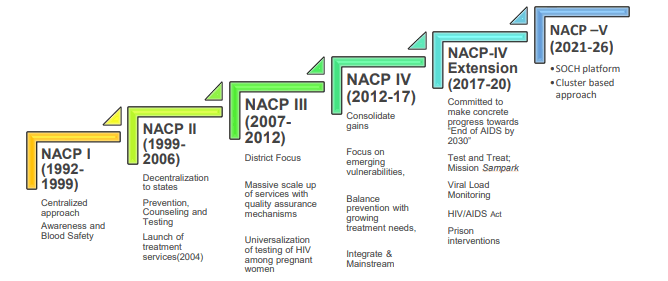
Figure 1: Evolution of NACP services.
Materials and Methods
Treatment and rehabilitation of the affected individual back
into the society. HIV/AIDS is being more of a social disease
than a clinical one where stigma and discrimination is very
strongly associated with the mode of transmission. Is
mandated to provide psychosocial support and dealing with
the issues of the person [2].
Issues with NACP Counsellor
In a study, almost all the counselors stated that they were
insecurities about their job as the posts have not been made
permanent and they fear of being transferred or worse, lay
off/losing the job. Most of the counsellor felt that there are
incidents of discrimination and indifferent behavior toward
them by both health care staffs and the clients. There is a lack
of ownership by the clinical staff in the healthcare facility
toward ICTC as an AIDS control program, as it is not a part of
National Health Mission (NHM). Clinical staff fails to recognize
the importance of counseling and sometimes even the clients
presume that the counselors are HIV positive individuals. The
joint United Nations programmed on HIV/AIDS (UNAIDS)
has widely promoted a slogan and goal to end HIV/AIDS by
2030. This has been unsettling news for the NACP staff
particularly the ICTC facility. On one hand it is great to
know that the mission is in the final phase of
implementation; on the other, it raises questions like “what
after that?”.
For ICTCs, a normal staff distribution is to have a counsellor, a
lab technician and a medical officer in-charge. For lab
technician and medical officer, it is relatively easier to move
and look for opportunities than for the counselor’s. Many of
the counselors have worked in the program for more than a
decade and many are in the late forties of their life. Although
with current numbers worldwide is suggests that it is very
unlikely to achieve the 2030 goal. But having said so it is also
essential to understand that there is an importance of
creating new roles and responsibilities for counsellors as there
are chances of HIV being an endemic (and not epidemic) to
certain parts in countries in the next decade or so which
eventually led to lean management and shredding of staff [3].
Counselling as Tool for Effective Treatment in NACP
Around the world, many researches explained the role of
counseling in improving the life of PLHIV and subsequently
helping the non-infected population to be aware of risk
behaviors. In Zimbabwe, study reported the importance of
counseling in improving the life of the positive people by
overcoming the isolation and be able to sharing feelings and
experiences. Similarly, in a study done in Uganda NGO’s
counseling support in district hospitals, counseling has helped
clients and their families to cope up with HIV and AIDS, with
90.4% of clients able reveal their serostatus to partners, and
57.2% have reported consistent use of condoms in past 3
months. As a result of counselling, more than half of the
clients (56.9%) prepared plans for the future and 51.3%
expressed to prepare wills. The level of acceptance for people
living (Figures 2 and 3) [4].
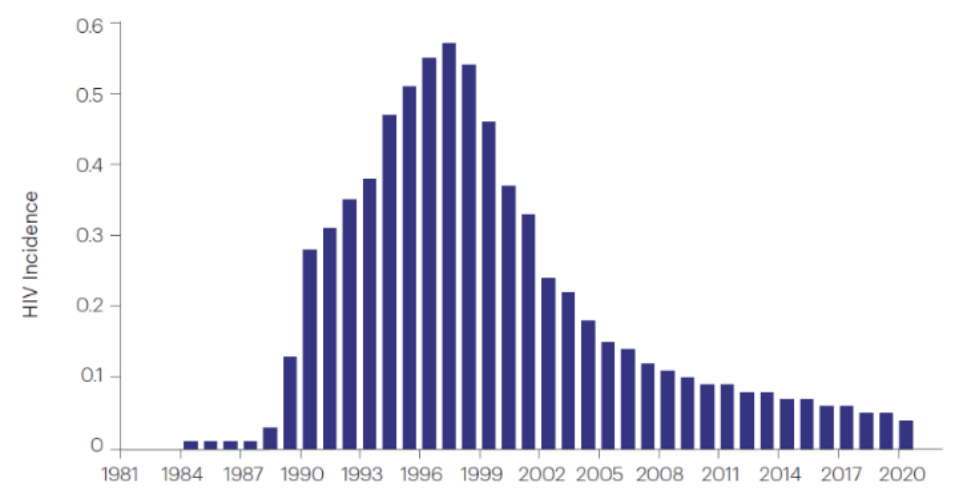
Figure 2: HIV incidence rates (NACO HIV estimates, 2020).
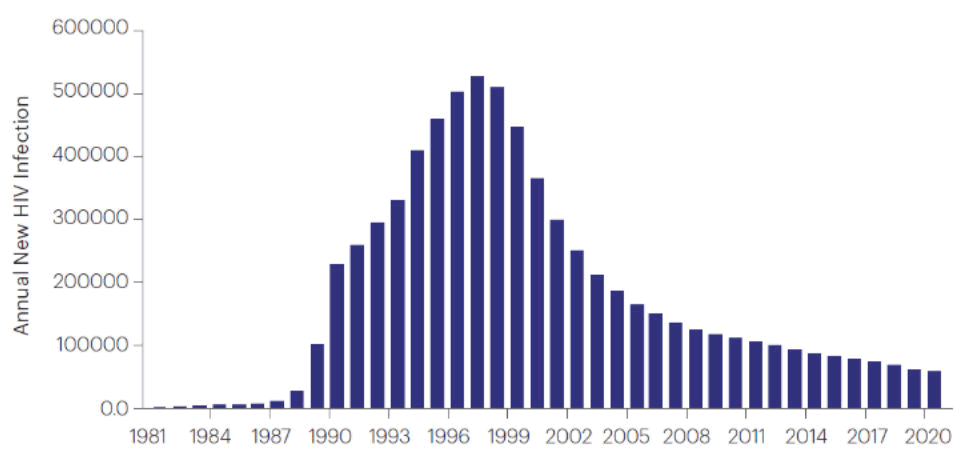
Figure 3: HIV annual new infections (NACO HIV estimates,
2020).
With HIV/AIDS (PLWHAs) by families (79%) and the
community (76%) was also found high.
HIV counseling and testing services were started in India in
1997. Counseling has been given very high importance in the
effective testing and treating of individual from NACP II
onwards. From NACP III onwards, district level integrated
counseling and testing centres have been installed to provide
effective counseling coverage to the self-stigmatised clients.
Moreover, many socio psychological and socio-economic
factors start affecting the clients who are HIV positive. Hence,
counselling becomes an integral part of national AIDS control
programme in diagnosis, prevention and control aspects
(Figure 4) [5].
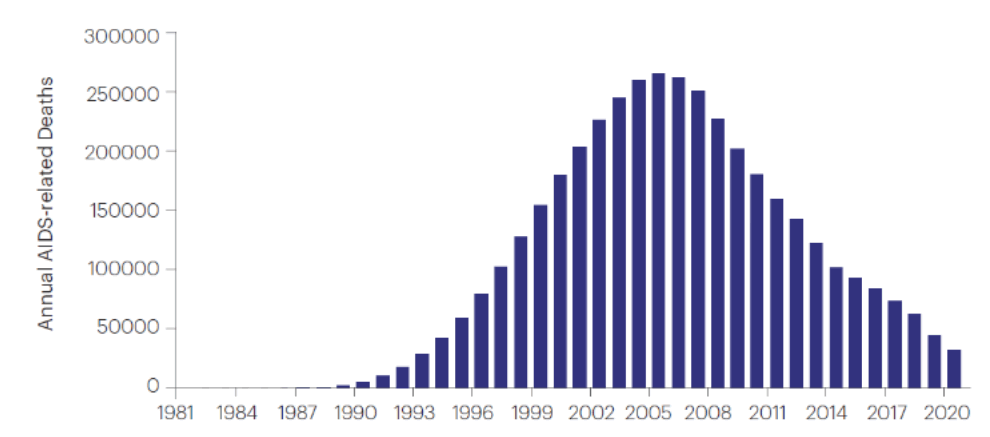
Figure 4: HIV annual AIDS related deaths (NACO HIV
estimates, 2020).
The effective of counselling evident from the fact that there is
effective reduction in rate of new infections and incidence
rates after the 1999 (NACP II). Although, there is a no. of
factors contributing; like more effective IECs, more availability
of treatment centers etc., but role of counselling in enabling
the client, to accept their status and reducing overall risk who
are not yet positive but in risky behavior, cannot be denied.
Effective counselling can mould the behavior of the individual
and enable them to make better life choices e.g., adhering to
the ARTs. The overall AIDS related death has also significantly
reduced after the introduction of the counselling in the
treatment module. Although, credit needs to be offered to
the newer ART regimen which were effective in controlling
the replication of virus. But enabling the client to adhere to
ART centres and taking medicines when there were high
chances of side effects of the medicine requires much
appreciation of their own. Outreach campaigns done by the
counsellors in the NACP III and IV have significantly increased
the social awareness amongst the mass and it is evident from
the reduced no. of incidents in uninfected population (Figure
5) [6].
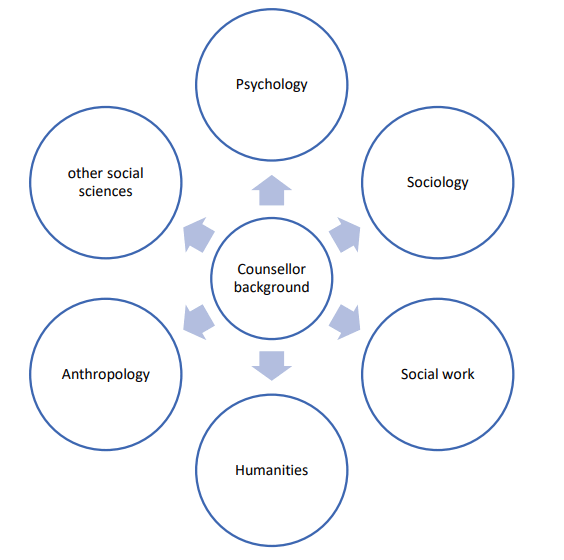
Figure 5: Counsellors' background.
NACP Counsellors as Healthcare Professionals
The counsellors in the NACP programmer currently, are
master of their trade. All of them have master’s degree in
social science subjects like psychology, sociology, social work
and other social science subjects to name a few. Many of
them are with the program since the initial inception of the
HCTS (HIV counselling and testing services) and have vast
experience of handling from general population to special
population issues of different strata of age-groups and discuss
some of the most difficult issues like sexual activity, gender,
sexual identity, risk behaviors to name a few [7].
A counsellor is an effective communicator, situational
manager, behavior change expert, educator, first point of
contact in both emergencies as well as in regular cases,
enabler, consistent psychosocial support to the clients and
honest reviewer. Even, sometimes, so that young client
sees counsellors as their role models or as the only
trusted source for information and advice. As a healthcare
professionals they carry the values of the profession, by doing
no-harm to the client and supporting in a professional way.
Over and above that, they protect the identity of the client and provide the most correct and right information, referrals,
behavioral and social advice to carry on in their life. All the
ICTC counsellors are placed into medical college hospital,
district hospital and CHCs wherever ICTCs are located. Staying
there, they have good liaison with the district administrations,
non-govt stakeholder and peer healthcare providers.
Skills and Capacity of NACP Counsellor
The training of the NACP counsellors has been a very
important aspect in the NACP. Capacity building skills for the
counsellor result in effective communication and
conversation develop counsellor into an effective enabler [8].
Technical Resource Group (TRG) in 2000 identified that there
is variety in standards of counselling across the nation and
there is a need for standardization. To meet with need Global
Fund for HIV/AIDS, TB and Malaria (GFATM), in round 7, and
NACO invited 6 counsellor training institutes to write a
proposal for standardize capacity building of counsellor.
‘Saksham’ project initiated through Tata institute of social
sciences, Mumbai in collaboration with 38 academic
institutions across the country. The training was initially
designed by plan India in collaboration with the prestigious
Tata institute of social sciences, Mumbai. Initially, trained in a
12 day in-house training with top trainers from TISS and later,
many received subsequent training (Figure 6).
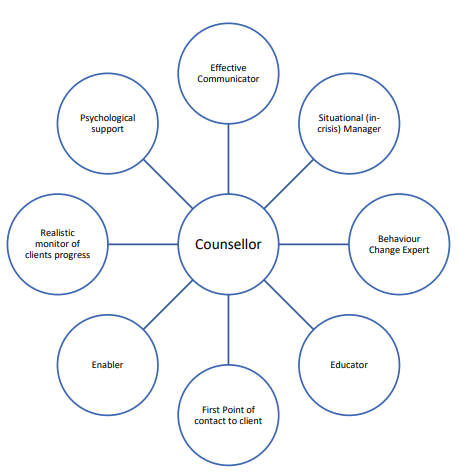
Figure 6: Counsellor role and responsibilities.
Shorter version CCT (Counsellor Contact Training) as refresher
for 5 days. The curriculum of the NACP counsellor has always
designed with the latest development in the field of
counselling and psychology. Sessions are stereotype breaking,
very engaging and educative which provided the exclusive
skills of client management with effective humanistic touch.
Sessions like “behaviour change communication” using the
transtheoretical model (James Prochaska) and “counsellor
self-awareness, attitudes values and ethics” have immensely developed the skill of a counsellor to produce desired result
[9].
Value of Counselling in Health Programs
The world health organization defines counselling like a wellfocused
process, limited in time and specific, which uses the
interaction to help people deal with their problems and
respond in a proper way to specific difficulties in order to
develop new coping strategies. Counselling increases the
ownership of the community and individuals in taking
responsibility and control of their own health, known as
“health promotion” (WHO, health promotion). Counselling
improves the communication between the client and the
healthcare providers, reduce stigma and self-doubt in clients,
help in coping with life situations and living positively,
maintain a self-image and self-esteem ease the work load on
the practitioners and staff nurse in their duty as they can
provide health education. The future of public health lies
around the idea of universal coverage and health equity
(Diversity, Equity and Inclusion or DEI) and the including
the counselling as an integral part of the healthcare
service delivery immensely support this notion [10].
Results and Discussion
Unfortunately, in this regard, nothing concrete is planned for
utilizing NACP counsellor. Moreover, important policy
documents like the High-Level Expert Group (HLEG) report
on universal health coverage misses out to even recognize
the counsellor as a Human Resource for Health (HRH).
Carrier progression of many clinical and allied human
resources has been discussed but there is no mention of
the counsellor. Accessibility of counsellor in the general
health setting provide equal opportunity to the community
and perceived as more familiar and friendly. It provides the
humanistic touch in the more and more digitalized
healthcare delivery paradigm [11].
Social Determinants of Health (SDOH) (WHO, social
determinants of Health, n.d.) are the non-medical factors that
influence the health outcomes of an individual or community
counselor can influence social determinant factors through
the inclusion and non-discrimination of clients and therefore
enhance the access and acceptability of the healthcare point.
This particularly important in the case of neglected population
like TG, IDUs. Counselling can provide more inclusivity,
acceptance and support system which can reduce the
incidents of discrimination, and also help reducing the
workload of the clinical staff in public health setting [12].
Visualizing NACP Counsellors in Different Roles
The NACP counsellor has the attributes to work in vivid
environment and have proven themselves in the past as
an effective (Figures 7 and 8).
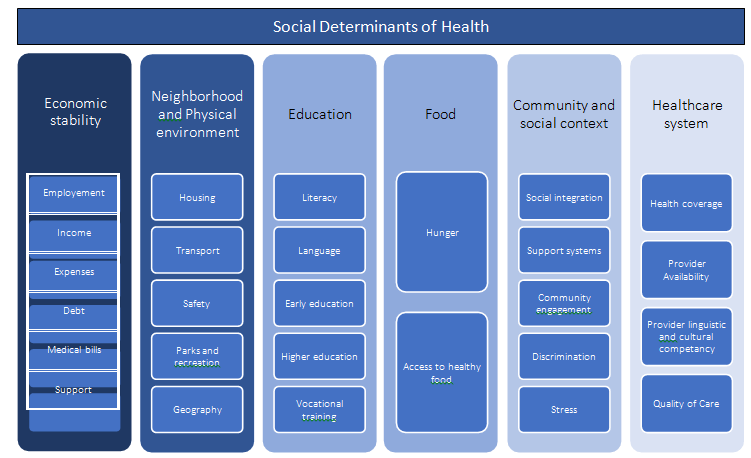
Figure 7: Social determinants of health.
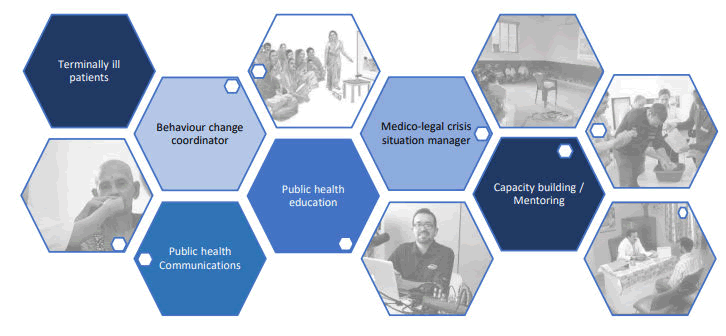
Figure 8: Visualizing various opportunities for NACP
counsellors.
Flag bearer of the national mission. Such skillful and
experienced workforce needs to be optimally utilized in the
existing healthcare system. Perhaps one of the very obvious
choices would be to utilize in the existing programs where
health promotion or social inclusion and elimination of
discrimination values more than clinical expertise, e.g. leprosy
eradication program, TB elimination program, Family
planning, adolescent and sexual education, WASH etc. are to
name a few. NACP counsellor can be an asset in outreach and
communication in case of public health, disaster
management, medico-legal and most important mental
health and suicide prevention emergency helplines as they
can provide the psychological comfort and establish
conversation with the caller/victim [13].
Further skill can be developed as an educator/behavior
change communicator for community mobilization and health
promotion. Also, by the virtue of immense experience in
dealing with difficult clients, the NACP counsellor have
immense potential as trainers/capacity building experts/
mentors for the clinical healthcare providers in behavior
management and inclusivity whether in AFHCs, RKSKs, health
and wellness centers or in general clinics etc. [14].
Many more opportunities can be opened when possibilities
are explored like inclusion in the maternal death frameworks
like SSSR model where counselors can be an important asset
due to their understanding in of the social structure and
institutions. Another valuable addition would be in terminally
ill patients e.g., cancer, chronic liver disease etc. Counsellor
can be a valuable addition in coping with the prognosis and
living remaining life in a positive way or help the family members to adjust to the new life situations more positively
[15].
Conclusion
Preparing and utilizing the existing experience resources into
future roles lies in the commitment of the state. Counseling
can be a bridge between the communities and the clinical
healthcare providers by fulfilling the psychosocial needs which
clinical fraternity not optimally equipped to serve. NACP
counselor’s do have a lot of potential and carry valuable
experience in the future roles of healthcare system.
Inclusion of the counselor’s into variety of programs will be a
win-win for all, the patients will get a professional therapy
from a counsellor, clinical practitioner will have their load
shared out and counsellor will have better prospects, job
satisfaction and security while simultaneously increasing their
interpersonal communication skills.
References
- Assefa Y, Gilks CF (2020) Ending the epidemic of HIV/AIDS by 2030: Will there be an endgame to HIV or an endemic HIV requiring an integrated health systems response in many countries? Int J Infect Dis. 100:273-277.
[Crossref] [Google Scholar] [PubMed]
- Khan FA, Fisher MA, Khakoo RA (2007) International journal of infectious diseases: Official publication of the international society for infectious diseases. Int J Infect Dis. 11(6):482-487.
[Google Scholar]
- Planning commission (2011) High level expert group report on universal health coverage for India. Working papers id: 4646, eSocialSciences.
[Google Scholar]
- Kaleeba N, Kalibala S, Kaseje M, Ssebbanja P, Anderson S, et al. (1997) Participatory evaluation of counselling, medical and social services of the aids support organization (TASO) in Uganda. AIDS Care. 9(1):13-26.
[Crossref] [Google Scholar] [PubMed]
- Khanna R, Subha Sri B, Srivatsan R (2017) Social determinants of maternal health: Dead women talking. In the social determinants of health in India: Concepts, processes and indicators. 189-207, Springer, Singapore.
[Google Scholar]
- Krabbendam AA, Kuijper B, Wolffers IN, Drew R (1998) The impact of counselling on HIV-infected women in Zimbabwe. AIDS Care. 10(2):25-37.
[Crossref] [Google Scholar] [PubMed]
- Papanna MK, Kumar P, Shetty A, Kulothungan K, Poojary IB, et al. (2016) Job perception of counselors employed at integrated counseling and testing centers for HIV in a district of South India. J Int Assoc Provid AIDS Care. 15(4):301-305.
[Crossref] [Google Scholar] [PubMed]
- Artiga S, Hinton E (2019) Beyond health care: The role of social determinants in promoting health and health equity. Health. 20(10):1-3.
[Google Scholar]
- Tamang B, Poudel PK, Karki SJ, Gautam R (2020) A mandatory bonding service program and its effects on the perspectives of young doctors in Nepal. Rural Remote Health. 20(1):5457.
[Crossref] [Google Scholar] [PubMed]
- Scott K, Shanker S (2010) Tying their hands? Institutional obstacles to the success of the ASHA community health worker programme in rural North India. AIDS Care. 22:1606-1612.
[Crossref] [Google Scholar] [PubMed]
- Dhadwal D, Bhardwaj A, Gupta A, Sharma S, Parashar A, et al. (2009) Role of intensive training in strengthening the skills of HIV counselors for imparting quality ICTC services. Indian J Community Med. 34(3):252-254.
[Crossref] [Google Scholar] [PubMed]
- Mukherjee JS, Eustache FE (2007) Community health workers as a cornerstone for integrating HIV and primary healthcare. AIDS Care. 19(1):73-82.
[Crossref] [Google Scholar] [PubMed]
- Kadri AM, Kumar P (2012) Institutionalization of the NACP and way Ahead. Indian J Community Med. 37(2):83.
[Crossref] [Google Scholar] [PubMed]
- Nebhinani M, Saini SK (2021) Leveraging role of non-physician health workers in prevention and control of non-communicable diseases in India: Enablers and challenges. Fam Med Prim Care Rev. 10(2):595.
[Crossref] [Google Scholar] [PubMed]
- Josyula KL, Sheikh K, Nambiar D, Narayan VV, Sathyanarayana TN, et al. (2016) Getting the water-carrier to light the lamps: Discrepant role perceptions of traditional, complementary and alternative medical practitioners in government health facilities in India. Soci Sci Med. 166:214-222.
[Crossref] [Google Scholar] [PubMed]
Citation: Singh R, Bhatta S (2023) Visualizing NACP Counselor’s Role in Public Healthcare System Paradigm in India. Br J Res.10:22.
Copyright: © 2023 Singh R, et al. This is an open-access article distributed under the terms of the Creative Commons Attribution License, which permits unrestricted use, distribution, and reproduction in any medium, provided the original author and source are credited.









